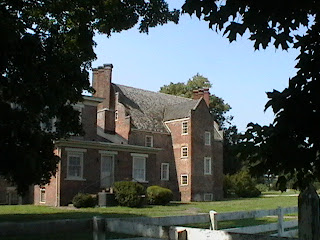The last official owners of the plantation were Victor and Evelyn, who did a lot for the conservation of the mansion and the surrounding lands. It was a very beautiful place to visit!
 |
| Chippoke's Plantation House Mansion |
After visiting Chippoke's, we went on to Bacon's Castle for an intro into dueling and a talk on slavery. We observed the changes that had been made to slave's housing in order to prevent rebellions (they had 'nicer' houses, with white-washed siding, they had raised foundations so that nothing could be hidden under the house, they were closer to the main house so that there could be more supervision), and got to go inside one of the houses. We went up to one of the upstairs rooms, and it was ridiculously hot up there.
 |
| A slave house at Bacon's Castle. Note the raised foundations. |
Then, we went around to the front of the estate to hear a story about a duel, and received an introduction to the concept of southern honor. The house was beautiful, and I'm only sad that we didn't get to go inside of it.
My paragraph for class:
Because of past slave uprisings, such as Nat Turner’s Rebellion and Gabriel’s Rebellion, slave owners lived in fear of future rebellions, and took more drastic measures to ensure that their slaves couldn’t revolt. In previous eras, slaves had been able to keep a few objects for themselves, usually under a floorboard or in a small hole under their house. When panic spread about uprisings though, many slave owners raised the houses, putting empty space between the bottom of the house and the ground. While this kept slaves from stockpiling weapons, it also kept them from having their own, completely innocent, objects. Another major change in masters of the time was paternalism, and the ideas that sprung from it. They kept up slave quarters and improved the quality of the housing (walls were painted white, the buildings looked nicer, etc.), but in such a way that it appeared that their slaves were no more than children who had to be taken care of.



No comments:
Post a Comment